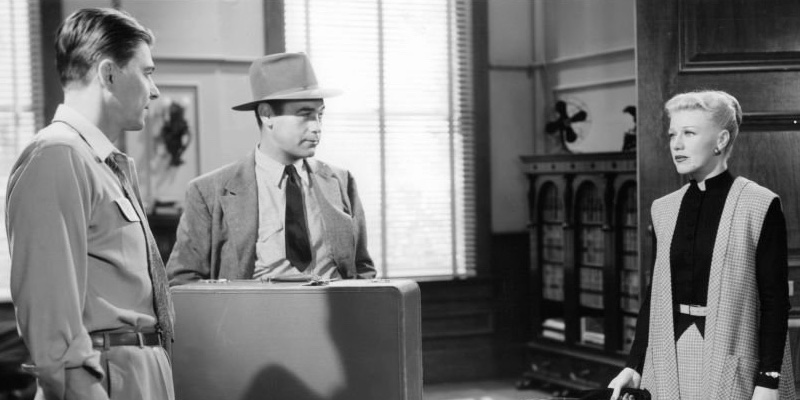In a summer when white supremacists have marched through the streets of Nashville, about three hours from me, it’s safe to say that a noir movie from 73 years ago is in some ways as relevant as when it was released.
“Storm Warning,” from January 1951, is a movie that was never on my radar. I stumbled across it on TCM a while back and was intrigued by the idea of a noir treatment of the Ku Klux Klan’s crimes in a small town, with a cast that seemed unlikely: Ronald Reagan when he was still an actor, Ginger Rogers mostly after her career as Fred Astaire’s dance partner, Doris Day years before her fame as a star of romantic comedies, plus Steve Cochran and a good group of character actors.
“Storm Warning” was, despite or because of its subject matter and offbeat casting, a flop at the box office. “Quo Vadis,” “Show Boat,” “The African Queen,” “A Streetcar Named Desire,” Alfred Hitchcock’s “Strangers on a Train” and “The Day the Earth Stood Still” were among the biggest hits of the year, grossing multiples of the $1-million-plus that “Storm Warning” made in ticket sales.
Yet “Storm Warning,” like a lot of good films about important subjects, still has the power to move. That’s in part because director Stuart Heisler, best known for films like a big-screen treatment of “The Lone Ranger” TV series and Humphrey Bogart-led thrillers “Chain Lightning” and “Tokyo Joe,” does not shy away from graphic imagery of the Klan and its reign of terror: Robes and hoods, nooses and a tall burning cross are prominent.
There’s some valid criticism that the film does not depict the Klan’s violence toward African Americans. I assume because it is set in a small town, the movie’s targets of the Klan were targets of opportunity: a nosy newspaper reporter and a few white people who dared speak up. In my own hometown in the early 20th century, the Klan harassed Catholics and schoolteachers because there were so few Black residents to victimize.
“Storm Warning,” despite being forgotten now by many, remains a searing indictment of the KKK’s malignant and criminal presence at mid-century.
(And, by the way, “Storm Warning” is a Christmas movie.)
Pessimism that justice will be done – yet hope
We all know the Klan from history books, documentaries and popular entertainment: thousands of Americans, many in influential positions, not only terrorized those different from them but also made as much money as possible in the process. “A Fever in the Heartland,” the book by Timothy Egan about the KKK in my home state of Indiana, documents this malignant grift well.
So it’s really gratifying to see “Storm Warning” and its portrayal of small-town Klan members who are not only murderous but thieving.
It’s also gratifying that even with Reagan as a square-jawed prosecuting attorney, “Storm Warning focuses on its female lead: Rogers as Marsha Mitchell, a dress model, traveling by bus from New York to a Southern city. The bus stops for 10 minutes in a Southern town, Rock Point, and Mitchell decides to let her boss go on ahead and catch a later bus so she can visit her sister, Lucy, who she hasn’t seen in a couple of years. Lucy lives in the town and has told Marsha about her wonderful marriage to Steve, a local truck driver.
But as Marsha walks from the bus station to the bar and bowling alley where Lucy works, she hears shouts and fighting outside the jail. Around the corner, she sees that robed Klansmen have dragged a man out of the jail and plan to lynch him. When he gets away, they shoot him in the back.
Marsha gets a good look at a couple of the Klan members when they take off their hoods, so when she meets up with Lucy and goes to her sister’s home, she’s shocked to learn that one of the men she saw was her brother-in-law, Steve.
There’s not a long cat-and-mouse game that follows the revelation. Marsha – like any sensible person would – tells Lucy that she saw her husband kill a man. Lucy, played by Day as bubbly and enthusiastic, can’t believe it. She tells Steve, who tries to mitigate the damage by at first denying any knowledge of the incident and then minimizing his role in it.
Meanwhile, prosecuting attorney Burt Rainey goes to the crime scene to talk to police who are haltingly investigating. The dead man is Walter Adams, a reporter who had come to town to investigate the Klan. Police had arrested Adams for drunk driving and the Klan pulled him from jail to lynch him.
Rainey is, interestingly, bitter and pessimistic about the investigation. He knows that he won’t be able to get any witnesses – even sheriff’s deputies working in the jail – to testify. There’s a reference to the last lynching in town.
Rainey knows the murder is the work of the Klan, which is led by “respectable” businessman and mill owner Charlie Barr (Hugh Sanders). But can Rainey find someone to identify the murderers, or even finger the KKK in general for the crime?
A surprisingly bitter look at small-town America
The most realistic element of the story is that Marsha is terrified of getting involved in the investigation into the murder she witnessed. She also wants to protect her sleazy Klansman brother-in-law to protect her naïve sister. Rogers is great in this deeply conflicted role.
Reagan makes the transformation from reluctant to zealous to bitterly disappointed when his investigation is derailed by Marsha. A courtroom showdown does not go as expected, and the story’s climax is instead reserved for a truly frightening KKK cross burning and horsewhipping in the woods.
“Storm Warning” is a surprisingly bitter look at small-town America in the post-war years. This isn’t a kind-hearted town with some bad elements. Except for a few people, the townspeople are corrupt and willing to stand by and allow terrorism. As a radio reporter says, this is a town full of surly and violent people who have embraced evil.
From the start, with lying and violent townsfolk, to the climax, with sweet little girls at a cross burning, this could be the town we later saw in “Invasion of the Body Snatchers,” except aliens haven’t turned the town into pod people: racists have free run of the burg.
Reaction at the time was mostly positive
Newspaper film reviewers of 1951 seemed primed for “Storm Warning” and its exposeé of the Klan. Some wanted more of a focus on real-life Klan terror.
“A terrific melodrama based on bigotry and robed rule,” Cleveland’s Plain Dealer said, adding that the movie was “a better-late-than-never screen attack on the Ku Klux Klan.” (The Plain Dealer reviewer, W. Ward Marsh, noted that the victim killed by the KKK mob at the beginning is “neither a Negro nor a Jew,” but goes on to note that by subbing a newspaper reporter into the role of victim suggests he was there investigating earlier crimes.)
The Evening Star of Washington D.C. noted, “If it occasionally over-reaches itself, and it seldom does, put the mischance down to the authors’ own deep and justifiable anger.” The screenplay was written by Daniel Fuchs and Richard Brooks, the latter an eventual Academy Award winner whose work includes “Elmer Gantry,” “Cat on a Hot Tin Roof,” “In Cold Blood” and “Looking for Mr. Goodbar.”)
Ray Sprigle was a journalist who won the Pulitzer Prize for a 1938 series in the Pittsburgh Post-Gazette about the one-time Klan background of Alabama Senator Hugo Black, appointed to the Supreme Court by Franklin Roosevelt. In 1948, Sprigle “passed for Black” and traveled through the South. He turned that reporting into a book, “In the Land of Jim Crow.” Sprigle wrote about “Storm Warning” for Pennsylvania newspapers when the movie came out. “Here is no gentle entertainment to while away an afternoon or an evening,” Sprigle wrote. “Maybe it isn’t entertainment at all. … To me, at least, it came with the impact of a kick in the belly.”
Noting the noir theme of the plot of the movie, Sprigle recounts how, during his time in the South, he reported from a town in Georgia where women’s groups had pushed through changes that allowed local Black residents to vote in an election.
“A couple of days before the election, a parade of autos loaded with hooded figures traversed the Negro section. In the mailbox of each Negro home was dropped a small pasteboard replica of a coffin lettered KKK. Only a handful of Negroes dared vote.”
Sprigle goes on to note, “’Storm Warning,’ of course, ignores the racial angle. These are white folks who are terrorized by organized bigotry and hatred.”
“Maybe ‘Storm Warning’ isn’t a great picture,” Sprigle adds. “I haven’t seen enough pictures to judge. But it is a powerful and a compelling one.”
He’s right.
***
Keith Roysdon is a Tennessee writer who, while he was a newspaper reporter in Indiana, sometimes wrote about the Ku Klux Klan and its influence in small Hoosier towns. He won more than 30 first-place state and national journalism awards, including two for his four co-authored true crime books. He’s written more than 50 pieces for CrimeReads. His fiction has been published by Punk Noir, Cowboy Jamboree Press, Slaughterhouse Press and Shotgun Honey.

















